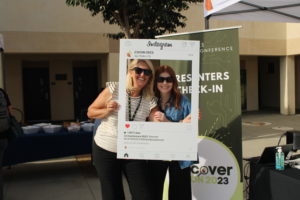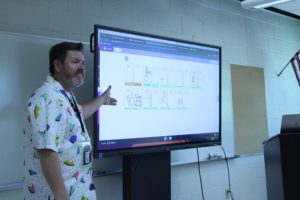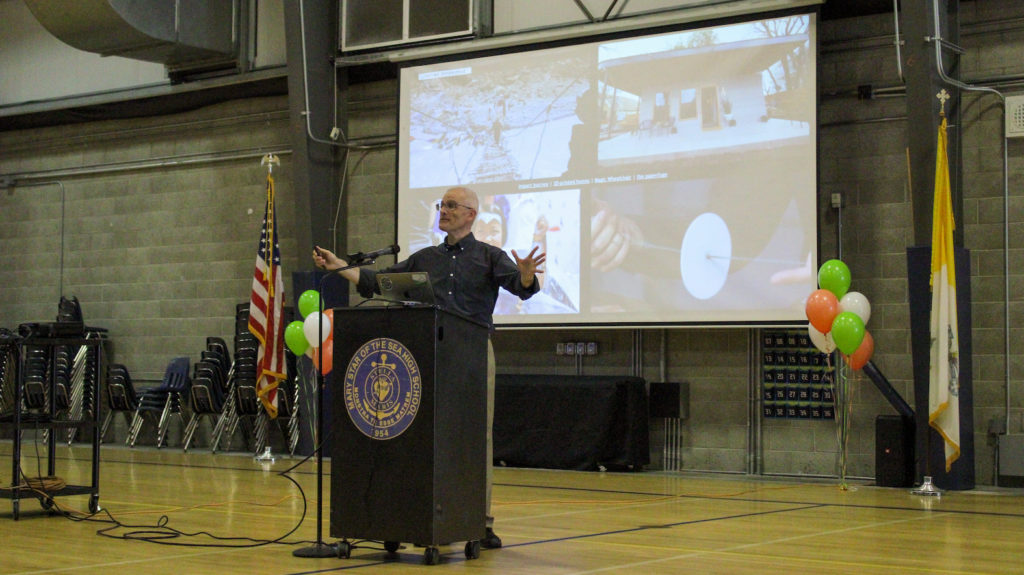For the hundreds of educators, school administrators, and faith leaders attending the 2023 Catholic Communication Collaboration, known as the C3 Conference, discussion about artificial intelligence (AI) wasn’t the elephant in the room so much as the camel in the gymnasium.
In other words: Get everyone over the hump.
The two-day conference on Aug. 1-2 put on by the Archdiocese of Los Angeles focused on technology and innovation that could enhance learning for schools and ministries in the archdiocese. But what most people wanted to talk about was getting comfortable with how AI — including tools such as ChatGPT and Google Bard — might be uploaded, harnessed, nurtured, or abused.
“Fascinating, powerful and worrisome,” said Rushton Hurley, the founder of the Santa Clara-based nonprofit Next Vista For Learning, who framed the overall AI concept during his half-hour keynote address titled “ChatGPT: An Earthquake in our Professional Land.”
Hurley, who also presented a workshop at C3 in 2019, set a positive tone about AI for attendees, focusing more on how to better assess the practical usage of this emerging technology rather than as something problematic and its potential to manipulate and compromise basic communication skills — especially harmful for unwary students who might see it as a shortcut on their educational journey.

Hurley, an innovation director at the Catholic college prep school Junípero Serra High in San Mateo and teacher of a purpose-driven class called “Creative Solutions for the Global Good,” said that as someone who grew up a Southern Baptist, he believes the approach that Catholics bring to education makes the transition to AI easier.
“The archdiocese in LA has made it clear they have people here to care about getting others up to speed,” Hurley said. “They have worked for decades on that goal, and you saw how it was put to use during the pandemic at a time when it was very easy for a lot of districts to throw up their hands. But the archdiocese found a way to make things happen for their kids.”
Topics of other technical innovation during the C3 Conference included new Google software applications, the launch of a new Catholic.Chat website to help answer faith-specific questions, advances in 3-D printing, robotics, and other STEM-related curriculum. But even discussions of those subjects circled back to how AI technology could affect their utilization.
More than 80 sessions were offered over the two-day event — one day virtual featuring attendees from across the country, one day in person at Mary Star of the Sea High School in San Pedro. C3 organizers estimate some 1,200 registered for the annual summit that the archdiocese has held annually since 2012.
Archbishop José H. Gomez welcomed the attendees in San Pedro by reminding them, “We all have a responsibility for using these new technologies to share our faith. These new technologies are a means, not the end or the goal of evangelization. The goal in this digital environment is the same as the Church’s mission in every place. We want to move people to a real encounter with Jesus Christ.”

John Wick, Ed.D., the principal at Holy Redeemer-St. James School in La Crescenta and CEO of WickEdLearning based in Long Beach, stressed the importance of dealing with AI head-on as part of the Catholic school’s ability to address moral responsibility with students.
“It matters how we approach this and because kids will use it whether we want them to or not, and I don’t like the idea of banning things,” said Wick. “Let’s address it and, as Catholic schools, let’s talk about the ethics. If Catholic schools can get ahead of it, they will produce students who effect better change.”
Hurley added that children may default to seeing AI as “the ultimate cheating tool” until the guiding forces in their lives help them see how it can be used honorably to accelerate learning.
“When we talk about the mechanics of tech, the children typically teach the adults,” said Hurley. “But the philosophy and perspective and insights and the larger systemic possibilities, that’s the realm of the adult. A kid can do what a kid knows and wants to do on a phone. Their creative response to the things we develop will dictate the ways we get further into the information age.”
Emma Pass, an English language arts teacher for seventh and 10th grade at the hybrid PSD Global Academy in Colorado, noted during her session titled “Digital Citizenship in a World of AI, ChatGPT and Machine Learning” that even while terms of use for ChatGPT (ages 13-18 with parental permission) and Google Bard (18 or older) may have restrictions, there is no age verification needed when creating an account. She said she mostly has her students write essays in the classroom where she can monitor them best.
Pass said because of the newness of these platforms, frequent discussions should involve students about how to be responsible, accountable, and transparent.
“It’s exciting that we can be part of this ongoing discussion,” she said, reminding educators about the mantra that we “aim to be empowered and not overpowered” by the AI progression.

Paulette Clagon, the principal at St. Gregory the Great Catholic School in Whitter, said her interest in attending sessions focused on her interest in how students can use AI to get immediate feedback from an authentically written piece before submitting work.
“When teachers teach the writing process then students will always have the brainstorming and create drafts before turning in the final paper checking for basic grammar and spelling,” said Clagon, who said she had been experimenting with AI for various administrative duties.
“It all has to be taught to the students the proper ways to use digital tools. I am very much for progress in technology. I can see it helping all people. We have to help our students put the gauge on their moral compass and learn with integrity.”
Sarah Gamboa, who teaches a combined fifth- and sixth-grade class at St. Paul of the Cross School in La Mirada, echoed what many attendees said about the C3 Conference helping them develop a better understanding of AI’s potential.
“A lot of young people today seem to carry around a lot of confidence with their knowledge of technology, but that doesn’t always mean what they’re talking about is accurate or representing the truth,” said Gamboa. “I’ve always been told that I was tech savvy, but things are moving so fast these days and it’s difficult trying to wrap my head around it all. Now I don’t see it as chaotic as I did before. I know how more to use it as a tool and a resource than something to be afraid of.”

